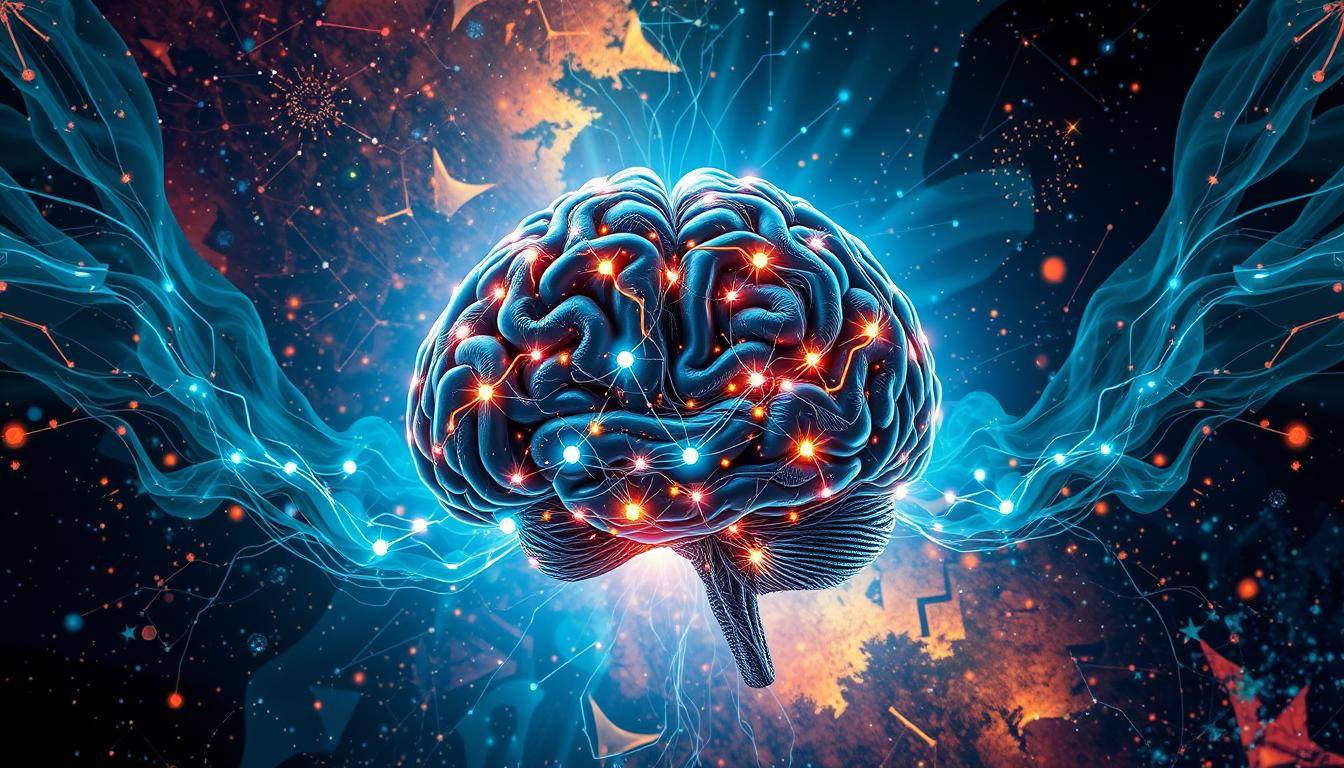“The greatest discovery of my generation is that human beings can alter their lives by altering their attitudes of mind.” – William James, American philosopher and psychologist.
William James’s words highlight the subconscious mind’s power to change. Neuroscience has shown us how our brains can change. This means we can change our thoughts and attitudes to be more positive.
By using neuroplasticity, you can change your subconscious mind. This opens the door to personal growth and happiness.
Key Takeaways
- Neuroscience research demonstrates the brain’s remarkable plasticity, enabling the reprogramming of thought patterns and mindset cultivation.
- Factors such as upbringing, society, culture, past trauma, and personal experiences influence our thoughts, but we have the power to challenge and reshape them.
- Intentional practice and strategies can help you overcome limiting beliefs and cultivate a more positive, empowering mindset.
- Neuroplasticity allows the brain to adapt and reorganize in response to new experiences and learning, forming the foundation for subconscious mind reprogramming.
- Cognitive restructuring and mindfulness-based interventions are key techniques for neural pathway restructuring and behavioral change.
Understanding the Power of Neuroplasticity in Mind Transformation
Did you know your brain can change and adapt? This amazing ability, called neuroplasticity, lets you make new neural paths and change old ones. By using neuroplasticity, you can change your mind and grow personally.
The Science Behind Brain Adaptability
Neuroplasticity is how your brain changes and adapts. It happens because of new experiences, behaviors, and environments. This process, or “brain rewiring,” helps create new circuits and gets rid of old ones.
How Neural Pathways Form and Change
Neuroplasticity is all about neural pathways in your brain. These paths can change with practice and repetition. By doing things that challenge your mind, you can make new connections and strengthen old ones.
The Role of Synaptic Connections
Synaptic connections are key in neuroplasticity. They help your brain adapt and respond to new things. By understanding these connections, you can unlock your mind’s full potential for change.
Tap into your brain’s amazing power with neuroplasticity. It can change your thoughts, habits, and well-being. The journey of brain rewiring is exciting, with endless possibilities.
“The brain has the ability to reorganize itself by forming new connections throughout life. This ability is known as neuroplasticity.”
The Foundation of Subconscious Programming
Your subconscious mind shapes your thoughts, beliefs, and actions. From birth, your early life and family shape your subconscious. This programming affects what you notice and how you think deeply.
Cultural norms and media also shape your subconscious. This can lead to beliefs that hold you back. Knowing your subconscious programming is key to change.
By 7-8 years old, people have strong beliefs from their early life. Their subconscious mind keeps learning and changing based on past experiences. It often rejects new ideas that don’t fit with what it already believes.
“The unconscious mind is a pervasive and powerful influence on higher mental processes, and research has challenged the conscious-centric bias in psychology, highlighting that the unconscious mind is not less complex, deliberate, or action-oriented than the conscious mind.”
To change your subconscious, you must understand your beliefs’ origins. Recognizing the patterns that shape your thoughts is crucial. This knowledge is the first step to taking control of your mind and making positive changes.
Neuroscience in Subconscious Mind Reprogramming: Current Research
Neuroscience has made big steps in understanding the human mind. It has given us insights into changing our subconscious mind. Modern brain imaging lets us see how our mind works, helping us understand our thoughts and feelings better.
Clinical Studies and Findings
Many studies have shown that certain methods can change our brain and behavior. Things like cognitive therapy and mindfulness have worked well. They help us change our deep thoughts and habits, letting us improve our mental state.
Modern Brain Imaging Techniques
New brain imaging tools like fMRI and EEG have changed how we study the brain. These tools let scientists see how our brain works in real time. They help us understand how to change our subconscious mind better.
Evidence-Based Reprogramming Methods
New methods based on brain science are helping people change their mind. Techniques like mental rehearsal and changing our environment can change our brain. This leads to lasting changes in how we act.
Using brain science in mind reprogramming has opened up new ways to grow and improve ourselves. As we learn more about the brain, we can change our mind in powerful ways. This lets us reach our full potential and overcome our limits.

The Mind-Brain Connection in Behavioral Change
Understanding how your mind and brain work together is key to lasting changes. Research shows that your thoughts and beliefs can change your brain’s structure and function. By focusing your mind and using certain strategies, you can build up the brain areas you want and weaken the ones you don’t.
This connection between mind and brain is the basis for many techniques in changing your subconscious mind. By changing your thoughts and beliefs, you can change your brain’s pathways. This leads to lasting changes in your behavior.
Studies show that changing behavior can take anywhere from three weeks to months. It takes a lot of willpower, which can get tired if you push too hard.
Neuroplasticity, the brain’s ability to change, is crucial here. It lets you shape your brain and build new habits. By using neuroplasticity, you can create positive changes in your life.
| Key Insights | Relevance to Behavioral Change |
|---|---|
| Behavior and feelings are contagious in relationships up to three degrees | Surrounding yourself with supportive people can make behavior change easier |
| Identifying and removing triggers that cause anticipatory dopamine releases | Can help motivate behavior change by eliminating cues for unwanted habits |
| Celebrating small victories along the way can help keep motivation high | Releasing dopamine through minor accomplishments aids in staying motivated |
| Starting with small changes one at a time is more effective than drastic overhauls | Minimizes the willpower needed and allows for gradual improvements |
By understanding the mind-brain connection and neuroplasticity, you can start a journey of change. Use the techniques that work for you and unlock your mind’s power. This will help you achieve the positive changes you want.
“The only way to make sense out of change is to plunge into it, move with it, and join the dance.” – Alan Watts
Advanced Techniques for Neural Pathway Restructuring
Exploring the human mind is a fascinating journey. Thanks to neuroscience, we now have powerful tools to change our brain paths. Techniques like cognitive behavioral therapy (CBT), mindfulness, and neurofeedback help us think, feel, and act differently.
Cognitive Behavioral Approaches
Cognitive behavioral therapy (CBT) is a proven method. It helps people change negative thoughts to positive ones. This way, CBT can change how we feel and behave for good.
Mindfulness-Based Interventions
Mindfulness, like meditation, changes our brain chemistry and activity. It teaches us to be present and accept things as they are. This reduces stress and helps us manage our emotions better.
Neurofeedback Training Methods
Neurofeedback is a groundbreaking method. It lets therapists work on specific brain areas. By giving feedback on brain activity, it helps the brain work better.
These advanced methods help us grow and change. By using cognitive behavioral therapy, mindfulness, and neurofeedback, we can discover our true potential.
“The brain is like a muscle – it gets stronger and more efficient through use.” – Norman Doidge, MD
Understanding the Role of Conscious and Unconscious Processing
Conscious and unconscious processing are key in subconscious mind reprogramming. Conscious efforts start the change, but the real shift happens at the unconscious level. The unconscious mind is active and complex, shaping our views, judgments, and motivations before we even know it.
The conscious mind only influences about 5% of our actions and choices. On the other hand, the subconscious mind controls a huge 95%. From birth to age 7, we soak up beliefs and fears that shape our unconscious mind. These early experiences set the stage for our future actions and reactions.
Changing the subconscious mind can lead to big changes in how we behave and see the world. Techniques like visualization help build new neural paths and open up new opportunities for growth. By working with our unconscious processes, we can tap into neuroplasticity and achieve lasting change.
“The problem of combinatorial complexity (CC) in modeling brain-mind processes was first identified in the 1960s and named ‘the curse of dimensionality.’ To illustrate the complexity, recognizing 100 elements could lead to 100^100 combinations, which exceeds the number of elementary particle events in the Universe.”
It’s vital to understand how conscious and unconscious processing work together for effective subconscious mind reprogramming. While the brain-mind connection is complex, using neuroplasticity and specific techniques can help us reach our full potential. This way, we can create the life we truly want.

Practical Applications of Neuroplasticity in Daily Life
The brain’s ability to change and adapt is called neuroplasticity. It helps us grow and reach our goals. By using neuroplasticity, we can change our habits and thoughts to match our goals.
Mental Rehearsal and Visualization
Mental rehearsal and visualization use neuroplasticity to change our subconscious mind. By imagining success, we create new brain connections. This boosts confidence and helps us overcome doubts.
Habit Formation Strategies
Habits are linked to neuroplasticity because they create brain pathways through repetition. Using techniques like mindfulness, we can change our habits. Consistency and self-discipline are key.
Environmental Conditioning Techniques
The environment affects our brain and habits. Environmental conditioning techniques make our surroundings support our goals. This could mean organizing our space or using sensory cues to help us.
“The brain has the remarkable ability to change throughout life, enabling learning, recovery, and adaptation.” – Norm Doidge, author of “The Brain that Changes Itself”
Neuroplasticity helps us achieve our goals through mental rehearsal and more. It shows how adaptable our minds are. This journey of self-discovery is amazing.
Overcoming Barriers to Mental Reprogramming
Starting a mental repatterning journey can change your life, but it’s not easy. Old negative beliefs, resistance to change, and the environment can block the way. But, with the right mindset and proven methods, we can get past these hurdles.
Being aware of ourselves is a big step. By watching our thoughts, feelings, and actions, we spot beliefs that hold us back. Challenging these beliefs and changing them to positive ones is key to lasting change.
Being kind to ourselves is also vital. Change takes time, and being gentle with ourselves helps us through the journey. Getting help from others, like a mentor or therapist, can also offer valuable support and motivation.
Dr. Joe Dispenza, a leading neuroscientist, has greatly contributed to mind reprogramming. He teaches us to align our thoughts, emotions, and actions to achieve our dreams. Through practices like visualization, meditation, and taking action, we can overcome barriers and unlock our mind’s power.
“The only thing that’s keeping you from where you want to go is the story you keep telling yourself.” – Dr. Joe Dispenza
To overcome barriers to mental repatterning, we need self-awareness, determination, and a willingness to try new things. By adopting a growth mindset and using proven techniques, we can reach our full potential and live the life we’ve always wanted.
| Technique | Description | Effectiveness |
|---|---|---|
| Affirmations | Positive statements that challenge and replace limiting beliefs | Safe and easy to use, can induce desired changes over time |
| Visualization | Imagining desired outcomes and aligning emotions with those visions | Requires some preparation but more potent than affirmations alone |
| Hypnosis | A structured approach combining visualization and affirmations, guided by a trained hypnotherapist | Highly effective in inducing subconscious change, but requires professional assistance |
Conclusion
Neuroscience has changed how we see subconscious mind reprogramming. It shows our brains can change and adapt in amazing ways. By using neuroplasticity, you can change your thoughts and grow personally.
This approach helps with mental health and self-improvement. It lets you control your thoughts, feelings, and actions. It’s a powerful way to improve your life.
Techniques like cognitive restructuring and mindfulness help change your brain. They help you overcome negative thoughts and align your mind for success. By focusing on your goals and staying positive, you can make your dreams come true.
Using neuroscience in subconscious mind reprogramming unlocks your brain’s full potential. It shows how our thoughts affect our feelings and actions. Start this journey to a better, more empowered you.
FAQ
What is the significance of neuroscience in subconscious mind reprogramming?
Neuroscience shows our brains can change and adapt. This is key for changing our thoughts and mindset.
How does neuroplasticity enable the reprogramming of thought patterns?
Neuroplasticity lets our brains make new paths. By repeating new thoughts, we can change our behaviors and thoughts for good.
What factors influence our subconscious programming?
Many things shape our subconscious, like our upbringing and past experiences. But we can change our thoughts with practice and effort.
What are the current research findings on subconscious mind reprogramming?
New studies show how to change our subconscious mind. They found methods like therapy and mindfulness work well in changing our brain and behavior.
How does the mind-brain connection influence behavioral change?
Our thoughts can change our brain. By focusing on new thoughts, we can build better brain connections and break old habits.
What are some advanced techniques for neural pathway restructuring?
Techniques like therapy and mindfulness can change our brain. They help us build new brain paths and change how we think.
What is the role of conscious and unconscious processing in subconscious mind reprogramming?
Both conscious and unconscious parts of our mind are important. Our unconscious mind often guides us before we even realize it.
How can individuals apply neuroplasticity principles in their daily lives?
We can use mental rehearsal and visualization to change our mind. Forming good habits and changing our environment also helps.
What are common barriers to mental reprogramming, and how can they be overcome?
Barriers include negative beliefs and resistance to change. To overcome them, we need self-awareness, persistence, and the right techniques.




























































